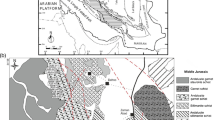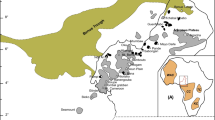Abstract
In the Myanmar jadeitite area of Pharkan, amphibole felses occur between jadeitites and serpentinized dunites. These so-called amphibole fels boundary zones were studied optically and by electron microprobe, and found to include the six amphibole species magnesiokatophorite (Mg-kat), nyböite (Nyb), eckermannite (Eck), glaucophane (Gln), richterite (Rich) and winchite (Win). In most samples, the two main amphibole species Mg-kat and Eck coexist with amphiboles containing variable amounts of components of the remaining four species, as well as with the clinopyroxenes jadeite (Jd), omphacite (Omp) and kosmochlor (Ko). However, Mg-kat, Nyb and Eck are also present as separate phases as well as in zoned porphyroblasts with Mg-kat in the core, Nyb in the inner rims, and Eck in the outer rims. The analytical data on such zoned amphiboles reveal that the chemistry changes from core to inner rim by virtue of the substitution NaAlCa−1Mg−1 (glaucophane vector), and from the inner to the outer rim along MgSiAl−1Al−1 (tschermak vector). The overall substitution from core to outer rim is, therefore, along NaSiCa−1Al−1 (plagioclase vector). Based on the Si content, three groups can be distinguished within Eck: Eck coexisting with Nyb has low Si contents of <7.6 a.p.f.u., Eck rimming Nyb has higher Si contents of 7.6–8.0 a.p.f.u., and fine-grained Eck in the matrix has Si contents of 7.9–8.0 a.p.f.u. Plotting the amphibole analyses in a compositional volume with the axes (Na+K) in A, Na in M(4), and tetrahedral Si shows that three groups of amphibole compositions can be distinguished, one being subdivided into three subsets. Group A contains Rich and Mg-kat, B comprises of Win and Gln, whereas the subsets C can be defined as follows: C1: high-Na amphiboles with low tetrahedral Si; these are mainly amphiboles from the Eck field but overlap with the two fields of Gln and Win; C2: high-Na and low-Si Ecks overlapping to high-Si Nybs; this group is midway between Eck and Nyb end members; C3: high-Na Mg-kats. Textural observations indicate three stages of sodic and sodic–calcic amphibole growth: stage 1 are amphiboles of group A (Mg-kat+Rich), stage 2 are amphiboles of group C2 (Nyb+Eck with Si<7.6 a.p.f.u.), and stage 3 are amphiboles of groups C1 and B (Eck with Si>7.6 a.p.f.u., +Gln+Win). Based on the subdivision into the compositional groups A–C, the only hint to a miscibility gap is provided by the large gap in the (Na+K) content on the A site which may point to a possible solvus in the system Eck–Win. Overall, the amphiboles investigated here show discontinuities in their growth compositions, rather than miscibility gaps. Textural observations suggest amphibole formation during fluid infiltration in the contact zone between the jadeitite bodies and the surrounding peridotite under high-pressure conditions (>1.0 GPa) and rather low temperatures of about 250–370 °C. Based on compositional trends within the amphiboles as well as phase-equilibrium constraints between amphibole and coexisting pyroxene solid solutions, the chemical composition of zoned amphibole porphyroblasts indicates two growth episodes—increasing pressures from stage 1 to stage 2 lead to the formation of Nyb from Mg-kat, and subsequently decreasing pressures lead to the formation of stage 3 Eck from Rich.
















Similar content being viewed by others
References
Abs-Wurmbach I, Neuhaus A (1976) Das System NaAlSi2O6 (Jadeit)–NaCrSi2O6 (Ko) im Druckbereich von 1 bar bis 25 kb bei 800°C. N Jb Mineral Abh 127:213–241
Bauer M (1895) On the jadeite and other rocks from Tawmaw in Upper Burma. Rec Geol Surv India 28:91–105
Bender F (1983) Geology of Burma. Bornträger, Berlin, 293 p.
Carman JH, Gilbert MC (1983) Experimental studies on Gln stability. Am J Sci 283A:414–437
Carswell DA (1990) Eclogites and the eclogite facies: definitions and classifications. In: Carswell DA (ed) Eclogite facies rocks. Blackie, New York, pp 1–13
Chhibber HL (1934) The Mineral resources of Burma. Macmillan, London, 320 p.
Colombo F, Rinaudo C, Trosarelli C (2000) The mineralogical composition of maw-sit-sit from Myanmar. J Gemol 27:87–92
Compagnoni R, Hirajima T, Chopin C (1995) Ultra-high pressure metamorphic rocks in the Western Alps. In: Coleman B, Wang X (eds) Ultra-high pressure metamorphism. Blackie, New York, pp 206–243
Deer WA, Howie RA, Zussman J (1997) Double-chain silicates. Geol Soc Lond, 764 p.
Dong SB, Cui WY, Zhang LF (1996) The Proterozoic Gln-schist and some eclogites in the northern Yangtze Craton, central China. Science Press, Beijing
Ghose S (1982) Subsolidus reactions and microstructures in amphiboles. In: Veblen DR (ed) Amphiboles and other hydrous pyriboles—mineralogy. Rev Mineral 9A:325–372
Ghose S, Forbes WC, Phakey PP (1974) Unmixing of an alkali amphibole (tirodite) into magnesio-richerite and magnesio-riebeckite. Indian J Earth Sci 1:37–42
Goffé B, Rangin C, Maluski H (2000) Jade and associated rocks from jade mines area, northern Myanmar as record of a poly-phased high-pressure metamorphism. EOS 81:F1365
Harlow GE (1994) Jadeitites, albitites and related rocks from the Motagua fault zone, Guatemala. J Metamorph Geol 12:49–68
Harlow GE (1997) Potassium in clinopyroxene at high pressure and temperature: an experimental study. Am Mineral 72:126–136
Harlow GE, Olds EP (1987) Observations on terrestrial ureyite and ureyiyic pyroxene. Am Mineral 72:126–136
Harlow GE, Sorensen SS (2001) Jade: occurrence and metasomatic origin. Aust Gem 21:7–10
Helper MA (1986) Deformation and high P/T metamorphism in the central part of the Condrey Mountain window, north central Klamath Mountains. Geol Soc Am Mem 164:125–141
Hirajima T, Compagnoni R (1993) Petrology of a jadeite/coesite-almandine-phengite fels with retrograde ferro-Nyb from the Dora Maira Massif, Western Alps. Eur J Mineral 5:943–955
Hirajima T, Zhang R, Li J, Cong B (1992) Petrology of the Nyb-bearing eclogite in the Donghai area, Jiangsu Province, eastern China. Mineral Mag 56:37–46
Holland TJB (1989) Dependence of entropy on volume for silicate and oxide minerals: a review and a predictive model. Am Mineral 74:5–13
Holland TJB, Powell R (1998) An internally consistent thermodynamic data set for phases of petrological interest. J Metamorph Geol 16:309–343
Htein W, Naing AM (1994) Mineral and chemical compositions of jadeite and associated minerals in jade from Myanmar. J Gemol 24:269–276
Htein W, Naing AM (1995) Studies on Ko, jadeite and associated minerals in jade of Myanmar. J Gemol 24:315–320
Johnson CA, Harlow GE (1999) Guatemala jadeitites and albitites were formed by deuterium-rich serpentinizing fluids deep within a subduction channel. Geology 27:629–632
Klein CJR (1969) Two-amphibole assemblages in the system actinolite-hornblende-Gln. Am Mineral 54:212–237
Kretz R (1983) Symbols for rock-forming minerals. Am Mineral 68:277–279
Lacroix A (1930) La jadeite de Birmanie: les roches qu'elle constitue ou qui l'accompagnent. Composition et origine. Bull Soc Française Minéral Cristallogr 53:216–264
Larson KM, Burgmann N, Bilham R (1999) Kinematics of the India–Eurasia collision zone from GPS measurements. J Geophys Res 104:1077–1093
Leake BE et al. (1997) Nomenclature of amphiboles. Report of the Subcommittee on Amphiboles of the International Mineralogical Association, Commission on New Minerals and Mineral Names. Am Mineral 82:1019–1037
Manning CE (1998) Fluid composition at the blueschist–eclogite transition in the model system Na2O–MgO–Al2O3–SiO2–H2O–HCl. Schweiz Mineral Petrogr Mitt 78:225–242
Mével C, Kiénast JR (1986) Jadeite-Ko solid solution and chromian sodic amphiboles in jadeitites and associated rocks from Tawmaw (Burma). Bull Mineral 109:617–633
Michael E, Dominik S, Maresch WV (2000) Ferric/ferrous iron ratios in sodic amphiboles: Mössbauer analysis, stoichiometry-based model calculations and the high-resolution micro-analytical flank method. Contrib Mineral Petrol 140:135–147
Mitchell RH (1990) A review of the compositional variation of amphiboles in alkaline plutonic complexes. Lithos 26:135–156
Molnar AR, Tapponnier P (1984) Cenozoic tectonics of Asia: effects of a continental collision. Science 189:419–426
Ni JF, Guzman-Speziale M, Bevis M, Holt WE, Wallace TC, Seager WR (1989) Accretionary tectonics of Burma and the three-dimensional geometry of the Burma subduction zone. Geology 17:68–71
OuYang CM (1984) Terrestrial source of ureyite. Am Mineral 69:1180–1183
Patriat P, Achache J (1984) India-Eurasia collision chronology has implications for crustal shortening and driving mechanism of plates. Nature 311:615–621
Pawley AR (1992) Experimental study of the composition and stability of synthetic Nyb and Nyb–Gln amphiboles. Eur J Mineral 4:171–192
Powell CM, Conaghan PJ, Klootwik CT (1985) India-Eurasia collision chronology. Nature 316:86
Reynard B, Ballevre M (1988) Coexisting amphiboles in an eclogite from the Western Alps: new constraints on the miscibility gap between sodic and calcic amphiboles. J Metamorph Geol 6:333–350
Robinson P, Spear FS, Schumacher JC, Laird JL, Klein C, Evans BW, Doolan BL (1982) Phase relations of metamorphic amphiboles: natural occurrence and theory. Rev Mineral 9B:1–201
Satyabala SP (1998) Subduction in the Indo-Burma region: is it still active? Geophys Res Lett 25:3189–3192
Shearer CK, Schumacher JC, Robinson P (1981) Zoned hastingsoite–ferri-katophorite–taramite phenocrysts, an amphibole + orthoclase = aegirine-augite + biotite reaction, and a new sodic amphibole in nepheline-sodalite syenite, Red Hill, New Hampshire. Geol Soc Am Abstr 13:552
Shi GH, Cui WY, Liou J (2001) The petrology of jadeite-bearing serpentinized peridotite and its country rocks from Northwestern Myanmar (Burma). Acta Petrol Sinica 17:483–490
Smelik EA, Veblen DR (1992) Exsolution of Ca-amphibole from Gln and the miscibility gap between sodic and calcic amphiboles. Contrib Mineral Petrol 112:178–195
Sorensen SS, Harlow GE (1998) A cathodoluminescence (CL)-guided ion and electron microprobe tour of jadeite chemistry and jadeitite petrogenesis. Geol Soc Am Abstr 30:A60
Sorensen SS, Harlow GE (1999) The geochemical evolution of jadeitite-depositing fluids. Geol Soc Am Abstr 31:A101
Sorensen SS, Harlow GE (2001) The jadeitites of Nansibon, Myanmar: records of the geochemistry of subduction zone fluids. In: CD-ROM 11th Annu V.M. Goldschmidt Conf, Lunar and Planetary Institute, Houston. Abstr #3800, LPI contribution 1088
Tropper P, Manning CE, Essene EJ (2000) The compositional variation of synthetic sodic amphiboles at high and ultra-high pressures. Contrib Mineral Petrol 139:146–162
Ungaretti L, Smith DC, Rossi G (1981) Crystal chemistry by X-ray structure refinement and electron microprobe analysis of a series of sodic-calcic to alkali-amphiboles from the Nybo eclogite pod, Norway. Bull Mineral 104:400–412
Welch MD, Graham C (1992) An experimental study of glaucophanic amphiboles in the system Na2O-MgO-Al2O3-SiO2-SiF4 (NMASF): some implications for Gln stability in natural and synthetic systems at high temperatures and pressures. Contrib Mineral Petrol 111:248–259
Acknowledgements
This paper has substantially benefited from the support of R.L. Zhang, X.L. Han, K.Q. Chen, B. Xu and R.X. Zhu during the fieldtrip and the subsequent research on these rocks. A few electron microprobe analyses on sample C were contributed by H.J. Bernhardt of the Ruhr-Universität Bochum, Germany. O. Medenbach at Bochum provided X-ray data on the AlSi phase. The authors wish to thank G.E. Harlow and P. Robinson for their very constructive, thorough reviews and encouragements which considerably helped to clear many issues concerning jadeitites and complex amphibole assemblages. In addition we would like to thank J. Konzett, W.V. Maresch, H.J. Wang and an anonymous reviewer for their constructive and thoughtful reviews which considerably improved an earlier version of the manuscript. The careful editorial handling, suggestions and comments of the journal editor Werner Schreyer were very helpful and are also gratefully appreciated. This research was supported by the CAS Foundation (KZCX2-104) and the Chinese Dr. Foundation (20010001017).
Author information
Authors and Affiliations
Corresponding author
Additional information
Editorial responsibility: W. Schreyer
Rights and permissions
About this article
Cite this article
Shi, GH., Cui, WY., Tropper, P. et al. The petrology of a complex sodic and sodic–calcic amphibole association and its implications for the metasomatic processes in the jadeitite area in northwestern Myanmar, formerly Burma. Contrib Mineral Petrol 145, 355–376 (2003). https://doi.org/10.1007/s00410-003-0457-y
Received:
Accepted:
Published:
Issue Date:
DOI: https://doi.org/10.1007/s00410-003-0457-y




